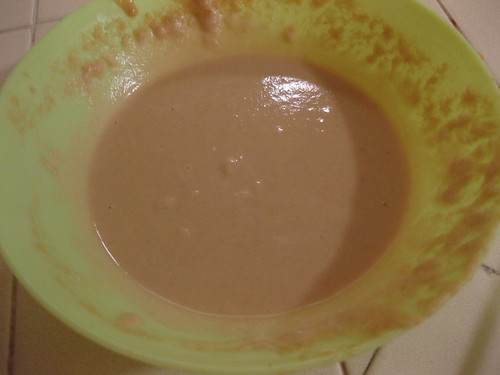
Welcome back to Beach City Cooking for the introduction of another ongoing feature: Thrifty Thursdays. The idea behind this series of articles is simple: every Thursday, I will provide simple, straightforward instructions for saving a lot of money by making certain ingredients and meals in the comfort of your own home. In today's post, for example, save over 85% off the retail price by making your own Tahini at home. And with homemade tahini, as you'll see, you can easily execute certain dishes that cost far more than they will to make at home.
The great thing about tahini--much like the praise I piled on eggs yesterday--is its versatility. That's an ongoing theme for me as a cook: how to stretch ingredients as far, and in as many different directions, as they'll go. One thing I love about cooking is that I can have any number of ingredients on hand, and make an infinite number of combinations of them. This goes back to my previously stated love of Vietnamese food. I also love the feeling of getting a great deal on something--who doesn't? This feeling is most prominent, for me, when it comes to food. There's something deeply satisfying about knowing your dinner would have cost $20 at a restaurant, but cost $5 at home. That feeling imbues every bite of your dinner, maximizing your enjoyment of it.
When you go to a supermarket or speciality grocer to pick up tahini paste, it usually runs you $6-$8 for a small container. Tahini is an especially foreign-sounding name, which, for me at least, left me clueless to its ingredients for the longest time. I guess I thought sesame seeds were involved, but I wasn't sure what other ingredients were in tahini. More than just the unusual name, it's the price tag that threw me, I think. Surely tahini paste must consist of more than just sesame seeds to warrant an average price of $7 for a small container?

As it turns out, not so much, no. Tahini really is just a correctly proportioned blend of sesame seeds and olive oil. Sometimes these sesame seeds are toasted, sometimes not. One immediate and wondrous effect of toasting your sesame seeds prior to preparing the tahini is that the toasted seeds smell incredible, as will your tahini. For the tahini itself, I followed this recipe from About.com's Middle Eastern Food site. Like Wikipedia, I find About.com to generally be a pretty all-encompassing resource for learning about different cuisines. They're probably a somewhat more reliable resource than Wikipedia.

The recipe on that page yields 4 cups, if you can get cheap sesame seeds in bulk at your local grocer, and have olive oil on hand, it's going to be ridiculously cheap to make. Plus, 4 cups is far more than you necessarily need to make, unless you're going to be catering a hummus lover's party. For the hummus, I used a recipe from Whats4Eats that requires 1/4 to 1/2 cup tahini. I went for the full 1/2 cup, but that still left me with plenty of tahini paste, considering I made about 1.5 cups of tahini (for about $1.40).

When you take into consideration the fact that the hummus cost about $2 to make for an amount that would easily cost $15+ in a store, that 1/2 a cup of tahini seems like an even better value. I'm basing this on the fact that I typically see pre-made hummus at the grocery store for $5 for a small container, or at a restaurant for $7.50 or so for a regular-size portion. This recipe yielded at least 3 times the amount you'd get in a small container at the store, or at least twice as much as you'd get in a shareable appetizer at a restaurant. So, I'd call the portion yielded by the recipe about $15 worth of store-bought or restaurant-obtained hummus. $13 off the price of hummus, bringing us to a grand total of $2 for a huge portion of hummus? I think that's a pretty terrific deal.

With some of your leftover tahini, be sure to make some taratour. With another recipe from Whats4Eats, I was able to make this Middle Eastern tahini-based sauce in mere minutes. The ingredients are salt, water, lemon juice, and tahini, with optional minced garlic cloves. I lived it up a little and added garlic, making the cost of the above-pictured portion of sauce about 35 cents, give or take. This is a pretty good deal as well, considering this sauce would probably cost $1.50 or $2 to get on the side at a restaurant. Whats4Eats suggests using this sauce for "shawarma, fish, falafel, kefta or over vegetables." The slight tanginess of the lemon juice helps offset the strong sesame flavor.

Thanks for stopping by BCC for this first edition of Thrifty Thursdays. I'll see you all tomorrow for that Japanese food-centric post (finally!). I think I got the pictures looking a lot clearer on the site, but if you're still experiencing issues, please let me know. Thanks to those of you who let me know about the problem. Have a great day, and stay cool!

Looks awesome, dude! I am putting this on my to-make list!
ReplyDelete